Zoom
Trash

The benign online disinhibition effect: Could situational factors induce self-disclosure and prosocial behaviors? Noam Lapidot-Lefler1, Azy Barak2 1 The Max Stern Yezreel Valley College & Oranim College for Education, Israel2 University of Haifa, Israel Abstract The current study, which focuses on the benign effects of disinhibition, was designed as a continuation of an earlier study conducted on the toxic effects of online disinhibition (Lapidot-Lefler & Barak, 2012).
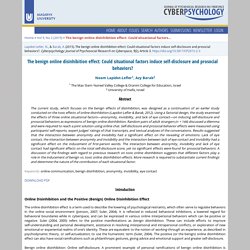
The Online Disinhibition Effect, 20 Years Later. As researchers like Norman Holland, Adam Joinson, and myself noted twenty years ago, people tend to say and do things online that they would not typically say and do in the in-person world.
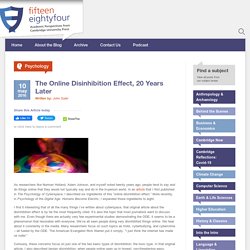
In an article that I first published in The Psychology of Cyberspace, I described six ingredients of this “online disinhibition effect.” More recently, in Psychology of the Digital Age: Humans Become Electric, I expanded those ingredients to eight. I find it interesting that of all the many things I’ve written about cyberspace, that original article about the disinhibition effect is by far the most frequently cited. It’s also the topic that most journalists want to discuss with me. Even though there are actually very few experimental studies demonstrating the ODE, it seems to be a phenomenon that resonates with everyone. Curiously, these concerns focus on just one of the two basic types of disinhibition: the toxic type. The Wild West. Measuring Fair Use: The Four Factors - Copyright Overview by Rich Stim - Stanford Copyright and Fair Use Center.
Unfortunately, the only way to get a definitive answer on whether a particular use is a fair use is to have it resolved in federal court. Judges use four factors to resolve fair use disputes, as discussed in detail below. It’s important to understand that these factors are only guidelines that courts are free to adapt to particular situations on a case‑by‑case basis. In other words, a judge has a great deal of freedom when making a fair use determination, so the outcome in any given case can be hard to predict. The four factors judges consider are: the purpose and character of your usethe nature of the copyrighted workthe amount and substantiality of the portion taken, andthe effect of the use upon the potential market. Ignore Heading – Sub heading content. More Information on Fair Use. Fair use is a legal doctrine that promotes freedom of expression by permitting the unlicensed use of copyright-protected works in certain circumstances.
Section 107 of the Copyright Act provides the statutory framework for determining whether something is a fair use and identifies certain types of uses—such as criticism, comment, news reporting, teaching, scholarship, and research—as examples of activities that may qualify as fair use. Academic Dishonesty. University Policy The University System supports and promotes academic honesty and personal integrity.
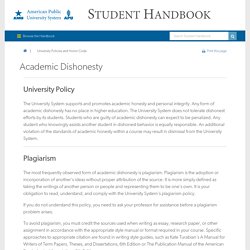
Any form of academic dishonesty has no place in higher education. The University System does not tolerate dishonest efforts by its students. Students who are guilty of academic dishonesty can expect to be penalized. Any student who knowingly assists another student in dishonest behavior is equally responsible. Plagiarism The most frequently observed form of academic dishonesty is plagiarism. If you do not understand this policy, you need to ask your professor for assistance before a plagiarism problem arises.
To avoid plagiarism, you must credit the sources used when writing as essay, research paper, or other assignment in accordance with the appropriate style manual or format required in your course. Types of actions defined as plagiarism: Plagiarism. Kids on Social Media and Gaming. Social Media Apps and Sites Commonly Used by Children and Teens Digital media and apps allow children to communicate and express their creativity, connect with peers, and share their feelings.
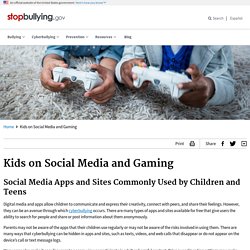
However, they can be an avenue through which cyberbullying occurs. There are many types of apps and sites available for free that give users the ability to search for people and share or post information about them anonymously. Online Bullying and Cyberbullying by Dr. Rosalind S. Dorlen. More than one in five children in the U.S. has been bullied and nearly 40 percent report having been assaulted by other youths, according to 2010 data from the U.S.
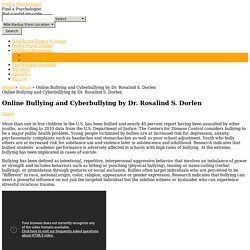
Department of Justice. The Centers for Disease Control considers bullying to be a major public health problem. Young people victimized by bullies are at increased risk for depression, anxiety, psychosomatic complaints such as headaches and stomachaches as well as poor school adjustment. Youth who bully others are at increased risk for substance use and violence later in adolescence and adulthood. Research indicates that bullied students’ academic performance is adversely affected in schools with high rates of bullying. Cyberbullying - National Bullying Prevention Center. Just as the use of technology itself has evolved, so has the ability to bully. Bullying, once restricted to the school or neighborhood, has now moved into the online world.
Bullying through the use of technology is referred to as “cyberbullying.” Cyberbullying is the use of technology to repeatedly and intentionally harass, hurt, embarrass, humiliate, or intimidate another person. As adults, thinking back, it was just a generation ago that kids and teens were asking their parents for a phone in their room — maybe even one with a separate line or three-way calling — so they could easily and somewhat privately connect with more friends. Today, a kid or teen’s desire to connect with friends has not changed, but the options for doing so have grown tremendously. Cyberbullying can happen anywhere there is online social interaction. Statistics.